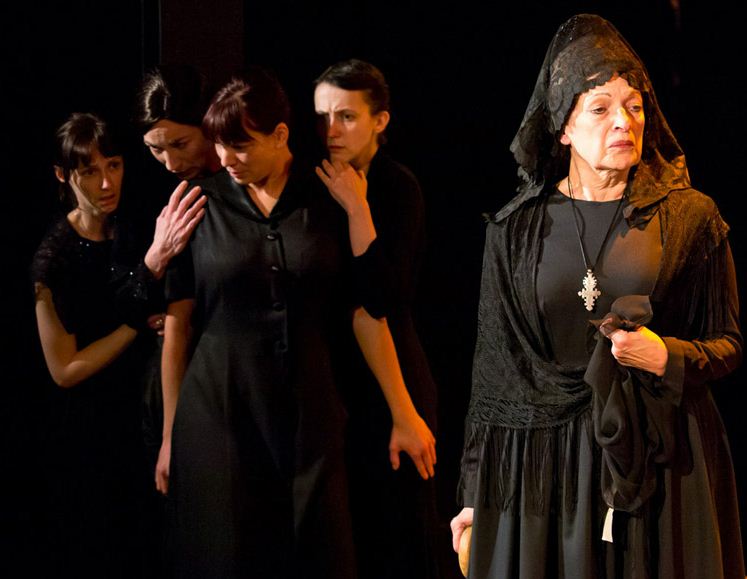Review: “The House of Bernarda Alba” by Federico García Lorca. Translated by Emily Mann. Directed by Charles Waxberg and Roy Arauz. Produced by Arouet. With Ruth McRee, Mary Murfin Bayley, Colleen Carey, Gina Marie Russell, Sarah Milici, Lorrie Fargo, Devin Rodger and Frances Hearn. Now through May 19, 2012 at The Ballard Underground.
Federico García Lorca’s complex and emotionally charged “The House of Bernarda Alba” is not the type of theater you would expect to see, or, for that matter, WANT to see in a small, underground theater space and produced by a small, low budget theater company. It’s a big play in every sense of the word, with a large cast that ranges in age from youth to aged 80 and stylistically it sort of demands a lot from both the design team and the production team. Not to mention that thematically, it’s a complicated, dark and perverse work of art…if you’re lazy about any aspect of the production, it could end up a Big Hot Mess.
“The House of Bernarda Alba” was Lorca’s final completed work; a few months after its completion, the Spanish Civil War broke out and Lorca, an opponent of the Franco regime, mysteriously disappeared in an apparent political assassination. The playwright and poet was only 38 years old. He was also a deeply conflicted gay man which directly influenced much of his work, notably in “Bernarda Alba”, a play without any physical male characters, only off stage ones who play an important role in the fate of many of the characters in the play. “The House of Bernarda Alba” takes place within the confines of a villa in Andalusia immediately following the death of the family patriarch. He is mourned in the opening scene, by his widow, Bernarda Alba and her five daughters and female servants and it is quickly established that Bernarda is a Matriarchal Monster who rules her family with an iron fist. She immediately decrees that the household will officially go into mourning for 8 years, virtually imprisoning her five desperate daughters. Only the oldest daughter, Angustias, Bernarda’s only daughter from her previous marriage, has any hope of escape; nearing 40 and plain, she inherited substantial money from her father and she plans on marrying her younger suitor, Pepe el Romano, who’s clearly marrying her for her fortune. Pepe is never actually viewed on stage; the entire cast is female, but Pepe is a pivotal character in the play. Two of Angustias’ sisters are also in love with him, the crippled Martirio, and the youngest daughter Adela, the only pretty girl in the family. The tensions between the sisters and their domineering mother are the driving force of the play and ultimately resolve in tragedy.
It’s a tough play. It’s overly dramatic, bordering on the melodramatic, and overplaying the drama can easily result in unintentional comedy…there are some florid lines and moments in “Bernarda Alba” and the character herself, a villainess of the old school, can easily become a cartoon. Bernarda also has a mad mother of her own living in the villa, the 80 year old demented Maria Josefa and she more than a little bit resembles Miss Havisham from Dickens’ “Great Expectations”. There’s a lot of room in “The House of Bernarda Alba” to go over the top and it could be quite easy for it to turn into a Spanish inflected “The Women”, Clare Booth Luce’s seminal all-female comedy from the same time period as “Bernarda Alba”.
Fortunately, Arouet’s production manages to stay on track, largely due to the direction by experienced Seattle director and teacher Charles Waxberg and Arouet founder/producer Roy Arauz. The big emotions of the play are still present, but kept in check, and they never overwhelm the drama. It’s evenly paced and the three acts of the play move swiftly and with a sense of purpose. The Ballard Underground isn’t the ideal space to present such a large and emotional work, but Mr. Waxberg and Mr. Arauz make ideal use of the space.
It also helps that the production has a large and largely gifted cast playing the main roles. Ruth McRee has the toughest job; Bernarda Alba is, frankly, a nasty old bitch who could easily end up a cartoon in lesser hands. But, Ms McRee manages to play the role to the hilt without crossing over into “The Land of Ham Acting”…it’s a big performance, but it’s a big role. She does a fine job and vocally, she calls to mind the great Welsh actress Siân Phillips, best known for her role as Livia in the BBC series, “I, Claudius”. Livia and Bernarda have a lot in common…monster mothers who will eat their young.
I was equally impressed with the five young actresses playing the sisters, though frankly they all appear to be in their 20’s when they should range in age from about 19 to about 40. Colleen Carey was very good as the nervous, oldest, “spinster” sister Angustias, though it must be said the actress is both far too young looking and far too attractive to convincingly play a plain old maid. Equally fine was Gina Marie Russell as the bitter, crippled sister Martirio; it was a lovely subdued performance from an actress who I’ve criticized on occasion for going “over the top” in other productions. Ms Russell’s work here is nuanced but still enthused with seething passion and the actress continues to impress us with her growth as an artist.
An actress new to me, was Sarah Milici, as the passionate youngest sister Adela. With her intelligent, focused and ultimately tragic performance, Ms Milici instantly joined my list of “Actors to Watch Out For”…she was very good conveying the youthful ardor and the tragic betrayal of her character. It was a strong performance from an actress with huge potential.
The two middle sisters are supposed to be a bit dull and “middle-sistery” but both Devin Rodger as Magdalena, and Lorrie Fargo as Amelia give excellent performances that made their characters complicated and interesting and vital to the production. Both actresses are new to me, but I want to see more of them, as well.
Finally, of the primary roles in the play, there are Mary Murfin Bayley as the sardonic housekeeper La Poncia, and Frances Hearn as the mad grandmother, Maria Josefa. I very much enjoyed Ms Bayley in last year’s Annex production, “The Tale of Jemima Canard” as Beatrix Potter; it was a lovely, carefully crafted performance. She’s much different here, as the rather coarse and conniving lynchpin that holds this fractured house together, and she’s equally adept at playing the cackling confidant to this troubled family. Ms Hearn has the difficult task of playing an 80 year old mad woman when she’s quite obviously not anywhere close to the correct age, but she nicely manages to convey both the age and the madness without resorting to soap opera theatrics.
All in all, the acting was strong in “The House of Bernarda Alba” and aided by the confident direction, this is a production I can recommend for serious fans of classic theater. But, I do need to note that technically the show is very simple. The Ballard Underground has a very simple light grid and Arouet isn’t a big budgeted theater company. The lighting, sets and costumes were effective and appropriate and well executed under the circumstances but if you’re looking for big, showy production values, you’ve obviously never attended a show at The Ballard Underground. But, I do want to give kudos to Kristina Hestenes Stimson for her costume design, which nicely manages to convey both the time and place and personalities of all the characters, and all on a tiny budget. Job well done.
Bernarda Alba is a nasty old woman and I wouldn’t want to live in her house, but I can certainly recommend paying her a visit.













[…] Arouet’s “The House of Bernarda Alba” is Well Worth aTrip to Ballard Michael Strangeways, Seattle Gay Scene […]